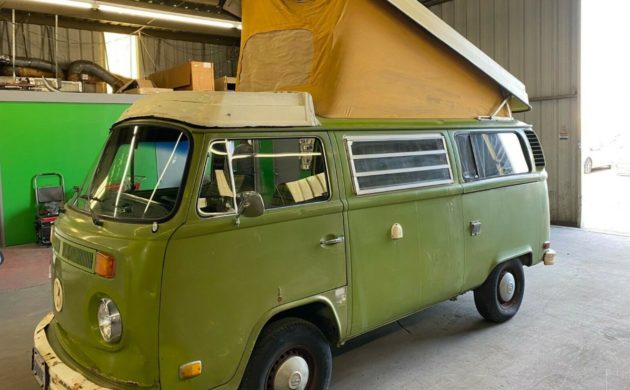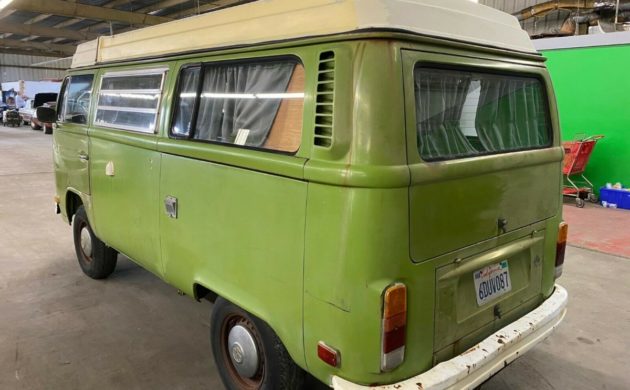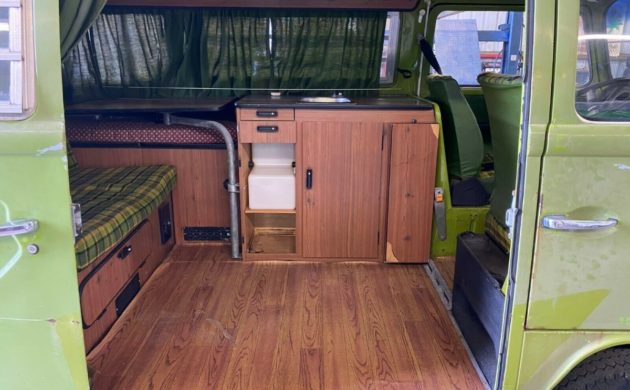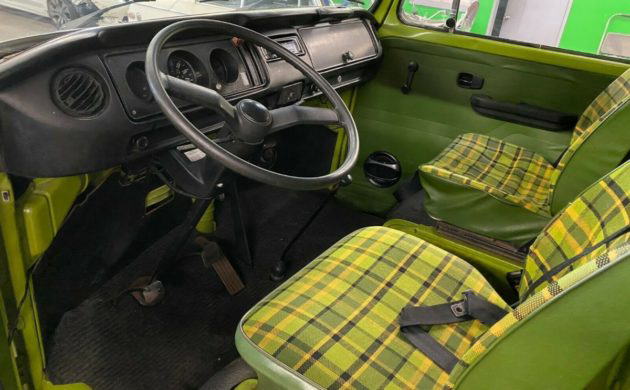This 1978 Volkswagen Bus is genuine Westfalia model with the pop-top camper roof and the complete assortment of cooking and lounging equipment inside. The exterior is rough in places and cosmetics are definitely a priority for the next owner, but the Bus runs and drives and sounds quite healthy, according to the seller. To me, bodywork is straightforward compared to trying to find the original camping equipment in good shape when restoring a Westfalia, so this example seems like a good buy with no reserve price to clear. Find it here on eBay in Moreno Valley, California with bidding approaching $8K at the moment.
There’s an orange one of these in a junkyard that’s local to me here in Rhode Island, and it breaks my heart to see it rotting away. It still has the pop-top, the interior equipment, and even the original hubcaps like this one, but the body has been absolutely ravaged by rust. This Bus, if it’s been in California most of its life, has avoided the destruction caused by the tinworm, but also managed to not become a casualty of the West Coast culture of living in your van year-round. I’ve got nothing against it (would love to do it someday, actually) but my trips to Oregon and California have shown me that some people can’t handle the maintenance realities of residing in a camper full-time.
What I mean by this is that the original camping equipment is fragile, and needs to be treated with some level of care if you’re going to live in a space this small. Fortunately, the previous caretakers of this Westfalia have clearly loved their home away from home, as the sink and cooking spaces, along with the bed, storage cubbies, and curtains, all appear to be in great shape. I do wonder if the original equipment was designed to be fairly hardy, as the junked example near me – despite having some missing windows – retains its full wood paneling on the sink and stove areas, with surprisingly modest signs of deterioration. The laminate wood-look floors are a nice upgrade on this example.
The tartan green cloth is a favorite of mine, and almost all Westys have this pattern with the colors dictate by the exterior – green vinyl and orange vinyl being rotated out according to the exterior paint color. The driver’s compartment is in outstanding condition, and the dash shows no signs of cracks. The door panels have aftermarket speakers installed, but they’re not particularly noticeable. The seller states that after some fresh fuel and a new battery, the Bus fired right up, and that the brakes, clutch, and four-speed transmission all operate as intended. A tune-up is still recommended along with some bodywork, but to me, the hard parts are intact on this example.






Would seem the driver and passenger seats have been switched, unless the owner had a really fat dog.
These will oxidize before your eyes given half a chance. In the mid 70’s, while a poverty-stricken college student, I bought a ’68 Camper basically identical to this one. It had what I *thought* was just some light surface rust and *maybe* a tiny little bit of bubbling on the panels and doors. When I touched my wire brush drill attachment to the rust for what I thought would be an easy weekend of light touch-up, all the metal disappeared. Literally. All of the lower 18 inches of bodywork on all the panels completely disappeared in a massive paint and rust colored cloud. The paint was the only thing holding the exterior together. 8 years of upstate New York winters and salty winter roads had done quite a number on the metal and sent it well on its way to returning to the elements from whence it originally came.
I panicked. I now had a camper with massive gaping empty spaces where metal was supposed to be. Having no money, I did what many of us did back then. I filled the empty spaces with wadded up newspaper, screen mesh, and pretty much anything else I could find. I then bought a couple (yes, two) 5 gallon buckets of Bondo, the wonderful all-purpose car restorer’s dream, and proceeded to smack it onto the balls of newspaper and screening with a small shovel. Lots and lots of bondo and even more sanding later, a thick layer of paint was sprayed on. It looked surprisingly good, though all the panels had a strange, solid-sounding ‘thunk’ to them when rapped, not the ringing ‘twang’ you would expect of metal.
It held together for the year or so I owned the camper. I had many wonderful camping experiences in it all over the east coast. By today’s standards it’s primitive, but to a 19 year old in the mid 70’s, it was as luxurious as a penthouse suite at a 5-star luxury resort.
These are fun and interesting to drive. The forward view is both amazing and terrifying. There is literally nothing in front of you. Nothing. Your feet rest on the forward sheet metal. The only thing between you and an accident is a very thin sheet of metal a tiny fraction of an inch thick (some of us would mount the spare tire on the front bumper in the interests of having something absorb a frontal impact other than the driver’s legs). It would just touch 70 mph flat out, and could realistically cruise at 60-65, if it wasn’t loaded too heavily and the terrain was flat. Heat and defrosting was typical air-cooled VW, which means either nonexistent, or in the case of mine, plenty of heat but heavily laden with exhaust fumes. That winter I had to choose between having heat or brain cells. Heat won.
I had particularly memorable experiences in it with my love of my life, girl of my dreams, way out of my league, intelligent, interesting, fun, amazing, drop-dead gorgeous (did I mention she was genius smart and model-beautiful?) girlfriend at the time. All unbeknown to her over-protective over-bearing mother who never liked me (maybe it was my ZZ Top length hair and beard that she just couldn’t abide).
If her mother happens to remember me and is reading this, I’ve always wanted to tell you something: the chaperones you insisted on tagging along with us on our dates didn’t work.
Jeff, thanks for the memories (BTW, I’m in RI as well).
That interior colour scheme is enough to make me puke at first sight.